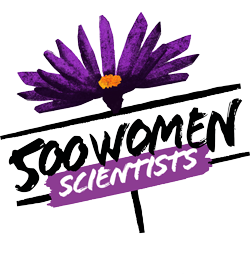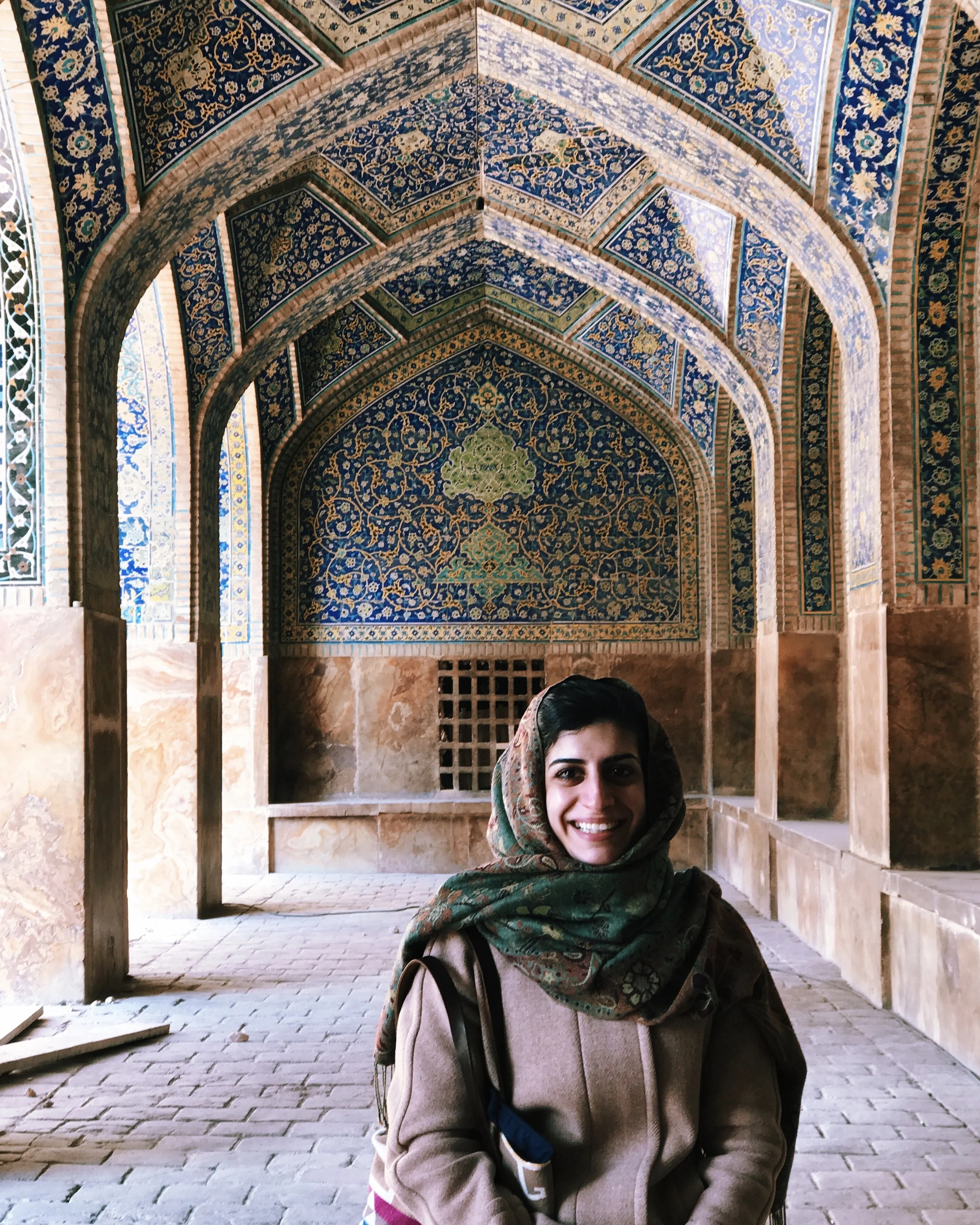Meet Maryam Zaringhalam. Photo by Nicholas Santasier.
As our network has grown over the last (almost!) three months, we have had the oppurtunity to meet some fantastic women. Today in our weekly #meetascientist, I have the pleasure of interviewing Maryam Zaringhalam. From art to advocacy, Maryam's activities demonstrate the role of creativity in the sciences and she is a wonderful example to other women searching for their voice in science.
You describe yourself as "Floating at the intersection of art x science x society x advocacy x STEMinism" what are your main activities that allow you to fit art and advocacy with your science? Why is it important to you that you float at this intersection?
Maryam and fellow Science Soapbox podcast team with 314 Action's founder Shaughnessy Naughton
I used to describe myself as someone struggling with an identity crisis because I’m drawn to so many things. I don’t feel that way anymore. There’s a tendency to think of science as this thing that exists in a vacuum and so scientists must exist in a vacuum to preserve their objectivity. But as I’ve grown as a scientist and a citizen, I see that’s completely absurd.
There’s creativity required to tackle scientific questions that resonates with the artistic process. There are the products of science that should have a positive, enriching impact on society. There’s a duty for scientists to advocate for why their work makes the world a better place. There’s a need to reform our society to make sure that we’re drawing from the best talent pool, regardless of gender, sexuality, or race. There’s a growing demand for science to be more inclusive to ensure that we’re asking a diverse set of questions that impact the whole world, and not just an elite few. It’s a chaotic intersection, but I’ve met some amazing people floating here!
What are some of your favorite projects in this intersection?
There are so many! I am a huge fan of the mobile microscopy lab BioBus and Rockefeller’s own outreach lab directed by the inimitable Jeanne Garbarino. Both have really been able to build a community around outreach, and are constantly listening to and experimenting with new and creative ideas. They’re real incubators for science education and literacy innovation here in NYC.
As far as science, art, and activism go, one of the most effective pieces I’ve seen is HOLOSCENES by Lars Jan. The piece centers on an aquarium installed in a public space that floods and drains while a person performs an everyday ritual. The idea is to speed up the timescale of global flooding and drought caused by climate change to connect them to our everyday activities in an attempt appeal to empathy. My crude description doesn’t quite do it justice, so here’s a video:
Then there’s Story Collider, which delivers true science-inspired stories to my podcast app once a week. It’s amazing to hear how science has affected folks from all walks of life in about a million different ways. Especially in this time, personal stories of what’s important to us and what shapes us make all the difference. I’ve told a couple stories for them and the experience of sharing something so personal with a live audience is hugely powerful.
There’s so much out there, so if you want more recommendations or have some to share, please do get in touch!
You have published quite a few essays and articles; why do you make science communication a priority?
To me, there’s nothing more important than having a voice. I was really shy and hesitant about sharing my thoughts when I was a kid, and I realized that being quiet allowed others to think whatever they wanted about me. So much of my identity today is bound up in being a scientist, so I wanted to figure out how to communicate it effectively and in a way that was true to my personality. Yes, science communication is important for increasing science literacy, which I care deeply about especially in today’s climate. But it’s also my way of expressing myself and what’s important to me to my friends and family outside the scientific community.
Maryam at a 'Save the ACA' rally in NYC.
You recently took a trip to Iran to visit your family which coincided with the travel ban, can you tall us a bit about that?
At a mosque in Esfahan, Iran
I was in Iran to visit my family in Tehran and to visit a couple cities I’d never traveled to before — Kashan where my dad’s family is from and Esfahan where my uncle’s family is from. I had a sinking feeling after the election results that travel would only become more difficult, and so I asked my mom if we could travel back so I could see the country. Sure enough, the Friday before we returned, the travel ban was signed. It broke my heart for all the obvious personal reasons, but also because, on a professional level, I’ve cultivated an interest in science diplomacy.
I wanted to use my identity as an Iranian-American to build science-based partnerships between the two countries, particularly because Iran has such a rich tradition of science and engineering. Many of America’s greatest women in STEM have come out of Iran — the Fields Medal-winning mathematician Maryam Mirzakhani, the engineer and space tourist Anousheh Ansari, and biologist and one of TIME’s 100 most influential people Pardis Sabeti. What affects scientists affects science. So I’m deeply concerned what our closed borders will do for the exchange of ideas and how that exchange reinforces diplomatic relations.
As an American citizen with Iranian roots, what has been your reaction to the immigration ban?
Many of my friends emailed me after the Executive Order was signed begging me to tell my family in Iran that the immigration ban did not reflect the majority of American values. Which was funny to my family and me. Iranians have long understood what it is like to live under a regime that does not reflect their values or their interests. Yet many Western leaders on both sides of the aisle have painted the Iranian people as a whole with a broad, negative brush. Now is a time to really look around the world at people different from ourselves to find points of commonality and learn from each other and signal to each other who we really are. Yes, it’s super kumbaya. But footage of peaceful American protests made it all the way to Iranian national television, which I watched with my family. So while we were hearing the latest soul-crushing policy developments, we were also seeing protests born of the kindness and compassion of Americans. And that made me proud.
How do you see the immigration ban specifically affecting women scientists?
When my dad came to America in 1968 to go to college. His English wasn’t very good, which made him a great listener. One of his classmates would confide some pretty racists things to him, while my dad sat quietly and listened. When my dad told me this story I asked him: “Didn’t he see you were Iranian?” And my dad responded that back then no one was afraid of Iran, or Islam
What I mean by that anecdote is that hate and fear are learned. In the 60s, Islam wasn’t the enemy. Today, Islamophobia lives in the White House. I fear that a new generation will learn to hate. Of course, a Muslim man doesn't look Muslim on the outside, while a Muslim woman is readily distinguished by her hijab or shayla. I worry that with Islamophobia seeping into the mainstream, women will be even more discriminated against for coming to an interview or into a lab covered. Which is why I think the scientific community has to be really loud and vigilant about why this ban is wrong. Scientists are not immune to discrimination. And I don't want Muslim women to become an even more underrepresented minority.
Maryam Zaringhalam is a molecular biologist who just received her PhD from The Rockefeller University. In the lab, Maryam tinkers with parasites and computers to understand how small changes to our genetic building blocks can affect how we look and function. When she's not doing science, Maryam runs ArtLab, a series that pairs scientists with artists, and podcasts with Science Soapbox, exploring science and policy. You can follow her science-ish musings on Twitter @webmz_ and read her work on webmz.nyc.






